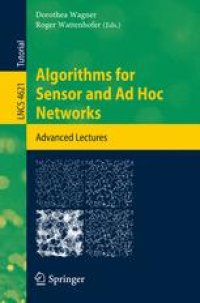
Ebook: Algorithms for Sensor and Ad Hoc Networks: Advanced Lectures
- Tags: Computer Communication Networks, Software Engineering, Algorithm Analysis and Problem Complexity, Information Storage and Retrieval, Information Systems Applications (incl.Internet), Communications Engineering Networks
- Series: Lecture Notes in Computer Science 4621
- Year: 2007
- Publisher: Springer-Verlag Berlin Heidelberg
- Edition: 1
- Language: English
- pdf
Thousands of mini computers (comparable to a stick of chewing gum in size), equipped with sensors,are deployed in some terrain or other. After activation thesensorsformaself-organizednetworkandprovidedata,forexampleabout a forthcoming earthquake. The trend towards wireless communication increasingly a?ects electronic devices in almost every sphere of life. Conventional wireless networks rely on infrastructure such as base stations; mobile devices interact with these base stations in a client/server fashion. In contrast, current research is focusing on networks that are completely unstructured, but are nevertheless able to communicate (via several hops) with each other, despite the low coverage of their antennas. Such systems are called sensor orad hoc networks, depending on the point of view and the application. Wireless ad hoc and sensor networks have gained an incredible research momentum.Computerscientistsandengineersofall?avorsareembracingthe area. Sensor networks have been adopted by researchers in many ?elds: from hardware technology to operating systems, from antenna design to databases, from information theory to networking, from graph theory to computational geometry.
Wireless ad hoc and sensor networks have gained an incredible research momentum. Computer scientists and engineers of all flavors are embracing the area. Sensor networks have been adopted by researchers from many different fields, ranging from hardware technology to operating systems, from antenna design to databases, from information theory to networking, from graph theory to computational geometry.
This monograph presents the outcome of a GI-Dagstuhl Seminar held in Dagstuhl Castle in November 2005. It gives a first overview of algorithmic results on wireless ad hoc and sensor networks. Its focus is on algorithms and protocols that allow for an analysis of their efficiency and efficacy. Many chapters deal with distributed algorithms, in particular local and localized algorithms.
Importance is attached to topics that combine both interesting aspects of wireless networks and attractive algorithmic methods. Each chapter provides a survey of some part of the field, while selected results are described in more detail. The structure and content of the book make it a suitable basis for an advanced course.
Wireless ad hoc and sensor networks have gained an incredible research momentum. Computer scientists and engineers of all flavors are embracing the area. Sensor networks have been adopted by researchers from many different fields, ranging from hardware technology to operating systems, from antenna design to databases, from information theory to networking, from graph theory to computational geometry.
This monograph presents the outcome of a GI-Dagstuhl Seminar held in Dagstuhl Castle in November 2005. It gives a first overview of algorithmic results on wireless ad hoc and sensor networks. Its focus is on algorithms and protocols that allow for an analysis of their efficiency and efficacy. Many chapters deal with distributed algorithms, in particular local and localized algorithms.
Importance is attached to topics that combine both interesting aspects of wireless networks and attractive algorithmic methods. Each chapter provides a survey of some part of the field, while selected results are described in more detail. The structure and content of the book make it a suitable basis for an advanced course.
Content:
Front Matter....Pages -
Applications of Sensor Networks....Pages 1-20
Modeling Sensor and Ad Hoc Networks....Pages 21-36
Clustering....Pages 37-61
MAC Layer and Coloring....Pages 63-80
Topology Control....Pages 81-98
Interference and Signal-to-Noise-Ratio....Pages 99-116
Lower Bounds....Pages 117-130
Facility Location....Pages 131-159
Geographic Routing....Pages 161-185
Compact Routing....Pages 187-202
Pseudo Geometric Routing for Sensor Networks....Pages 203-213
Minimal Range Assignments for Broadcasts....Pages 215-235
Data Gathering in Sensor Networks....Pages 237-263
Location Services....Pages 265-281
Positioning....Pages 283-304
Security....Pages 305-323
Trust Mechanisms and Reputation Systems....Pages 325-336
Selfish Agents and Economic Aspects....Pages 337-358
Time Synchronization....Pages 359-380
Back Matter....Pages -
Wireless ad hoc and sensor networks have gained an incredible research momentum. Computer scientists and engineers of all flavors are embracing the area. Sensor networks have been adopted by researchers from many different fields, ranging from hardware technology to operating systems, from antenna design to databases, from information theory to networking, from graph theory to computational geometry.
This monograph presents the outcome of a GI-Dagstuhl Seminar held in Dagstuhl Castle in November 2005. It gives a first overview of algorithmic results on wireless ad hoc and sensor networks. Its focus is on algorithms and protocols that allow for an analysis of their efficiency and efficacy. Many chapters deal with distributed algorithms, in particular local and localized algorithms.
Importance is attached to topics that combine both interesting aspects of wireless networks and attractive algorithmic methods. Each chapter provides a survey of some part of the field, while selected results are described in more detail. The structure and content of the book make it a suitable basis for an advanced course.
Content:
Front Matter....Pages -
Applications of Sensor Networks....Pages 1-20
Modeling Sensor and Ad Hoc Networks....Pages 21-36
Clustering....Pages 37-61
MAC Layer and Coloring....Pages 63-80
Topology Control....Pages 81-98
Interference and Signal-to-Noise-Ratio....Pages 99-116
Lower Bounds....Pages 117-130
Facility Location....Pages 131-159
Geographic Routing....Pages 161-185
Compact Routing....Pages 187-202
Pseudo Geometric Routing for Sensor Networks....Pages 203-213
Minimal Range Assignments for Broadcasts....Pages 215-235
Data Gathering in Sensor Networks....Pages 237-263
Location Services....Pages 265-281
Positioning....Pages 283-304
Security....Pages 305-323
Trust Mechanisms and Reputation Systems....Pages 325-336
Selfish Agents and Economic Aspects....Pages 337-358
Time Synchronization....Pages 359-380
Back Matter....Pages -
....